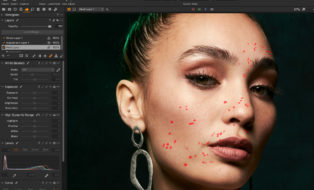It is in the Base Characteristics Tool that you set the Tone Curve and the ICC Color Profile for the file. Together these settings give the camera its overall look.
What does the curve do?
The curve describes the basic tone mapping of all pixels. By default the curve “Film Standard” is used. This curve is designed to give a similar tone mapping as when using transparency film. The curve has a slight S shape in order to achieve deep blacks while still maintaining details in the highlight, giving a gentle transition into overexposed areas.
The default ICC Color Profile is designed to work well together with the default curve “Film Standard” and should be used for classic photographic tasks like portrait, product or landscape photography.
For special photographic tasks or tricky images you can select other film curves like the “Film Extra Shadow”, “High Contrast” or “Linear”.
 No Correction Hand tweaked tone curve
No Correction Hand tweaked tone curve
The image to the left is straight out of the camera. The image to the right reflects correction of the image in Capture One Pro 7. This is achieved by taking full control of the tone mapping by first using the Linear Curve, in the Base Characteristic Tool, and then applying a “hand tweaked” curve in the Curve Tool. When performing this adjustment I can add much more contrast in the highlight to really show the circular ice crystal “rainbow” cloud.
The effect of 4 different Tone Curves
In the example below I have made 4 variants of the same image and have applied different Tone Curves from the Base Characteristics Tool to show their effect. The image has a wide dynamic range, retaining details in highlights, mid-tones and the shadows. In the reflection on the light pole data is clipped to 255. Underneath the cars in the shadow we have really deep black.
The Base Characteristics Tool is, by default, placed in the Color Tool tab. In order to show the effect on the image’s different variants, however, I have added the tool as a floating tool.
 A- Film standard B-Film Extra shadow
A- Film standard B-Film Extra shadow
 C- Film Extra Contrast D-Linear Curve
C- Film Extra Contrast D-Linear Curve
Image A: Using “Film Standard” shows a good compromise between highlight details, bright mid-tones and deep black shadows.
Image B: Using “Film Extra Shadow” has almost the same Tone Curve as the Film Standard but is more open in the shadows.
Image C: Using “Film High Contrast” has slightly deeper shadows and brighter highlights.
Image D: Using “Linear” looks underexposed and lacks contrast. Regardless the image has a full dynamic range and still shows clipped highlights on the light pole.
Why have the Linear Curve?
It is obvious that the Linear Curve makes the image look really dull so why do we have this option at all? There are two main reasons for having the Linear Curve:
- Scientific photography: You can achieve a perfect linear reproduction of your scene. Scientific flat-art reproduction is also an area where it can be of advantage in combination with specially made color profiles. For true flat art you don’t have the large dynamic range of the 3D world.
- Tricky images where you want to emphasize certain parts of the tone scale. By starting with a straight linear curve, it can be easier to take full manual control of the tone mapping in the Curves Tool. If you have the skills you may be able to achieve something you wouldn’t have been able to using the default curve.
The image on the left is using the default curve “Film Standard” in the Base Characteristics Tool and you don’t need to do anything to make the image look quite good. This normally gives you a very good starting point for further editing the image. The image to the right is using the curve “Linear” in the Base Characteristics tool. I have additionally made a curve in the Curve Tool to achieve almost the same effect as if I were using the “Film Standard” in the Base Characteristics tool. We can see the “S” shape of the curve, giving more solid blacks and a gentle transition into clipped data.
Let’s go back and look at the image of the old light house and select the Linear Curve in the Base Characteristics tool. We can then start playing with the Curve Tool from the Exposure Tool tab.
The left image is using the default curve “Film Standard” but the right image is using the Linear Curve. Already by simply loading the Linear Curve we get much better definition in the sky but it still needs work in the Curves Tool to get a useful image. If we look at the histogram we see 2 peak areas. The brightest are the tones in the sky; the darkest are the tones of the lighthouse and sand dunes. Because we have such a clear separation of tones, it will be possible to do quite a significant correction and still achieve an image that looks natural.
I start by increasing contrast to the sky. I do this by adding two curve points, done by simply clicking on the curve exactly over the histogram peak from the sky. To get contrast I need to make the curve steeper through this tone area. I simply drag the upper point until a get the desired amount of contrast.
Finally, I brighten the Lighthouse and the sand dunes. To do this I add a third point on the curve in the middle of the histogram peak associated with the lighthouse. By dragging this point up I brighten these tones.
I now have an image with much better balance between the “ring” sky and the details in the lighthouse.
All the best,
Niels

The Image Quality Professor
The digital pioneer, Niels V. Knudsen, is Phase One’s Image Quality Professor and founder of the IQP blog. Moreover, he is responsible for breakthrough advancements in image quality both in Phase One’s medium format camera systems and in Capture One Pro.








Thank you Niels for this awesome tip! I have discovered that my Nikon D7000 raw files benefit from using linear film curve because the standard film curve gives me way too much contrast for portraits. I shoot in adobe rgb and neutral settings on camera. Now, when I import my raw files I have made a preset to make linear film curve my default. This gives me more control and more natural skin tones. With standard film curve I noticed a stronger red shift.
Hi Rodolfo,
I am very pleased to hear.
All the best,
Niels
Actually if you are shooting in “Raw” then it doesn’t matter whether you have your camera set to adobe RGB or sRGB and neutral settings. These settings only apply if you are shooting jpeg.
Thanks Niels for your always very fine hints, suggestions etc. when working within CO, also for your last contribution with “Tone Mapping” – the example with the Light House. I wonder whether my guess is right. Couldn’t it be the Lighthouse of Rubjerg Knude near Løkken in the northern part of Jutland? I photographed this Light House from various angles on a wonderful day of february a couple of years ago when the sanded surface was covered with snow – it looked a little surrealistic, but was extremely beautiful. I Would have added the picture, but I don’t think that the blog allows that…
All the best, Per
Hej Per,
Great to hear that you are enjoying the tips. You are absolutely right, it is the Lighthouse of Rubjerg Knude near Løkken. Nicely spotted!
All the best,
Niels
Hi Per,
Great to hear that you are enjoying the tips. You are absolutely right, it is the lighthouse of Rubjerg Knude near Løkken. Nicely spotted!
All the best,
Niels
This is a great tip. I discovered the linear curve’s benefit when grading a blue sky to very dark grey (B&W conversion) I was able to retain extreme detail in cloud highlights as a result. This was not as possible with ‘film standard’ or in other software.
Nice article. Thx. But eben with the linear curve a gamma correction is applied. Right?
Hi Christian,
Yes, you are right. Gamma correction has been applied.
All the best,
Niels
Hi Niels,
Is there any option in Capture One 8 that would allow us to suppress the gamma correction so that even more highlight details can be retained when Linear Response is being used ?
Francis
Hi Francis,
You can of course choose an ICC destination workspace with gamma 1.0, but that won’t help you as when viewing the file this gamma 1.0 will be taking into account again together with the gamma for the display device.
The only way to get more high dynamic range when using a linear curve, is to combine it with a certain amount of highlight and shadow recovery.
All the best,
Niels
Hi Niels,
Thank you so much for the advice. It’s all that I would like to know. Thanks again.
Regards,
Francis
Hi Francis,
You are welcome. Glad you enjoyed the tip.
All the best,
Niels
Using Capture one Pro 7 with my Leaf Aptus 65 there is no linear curve option, just the curve options offered by Leaf Capture. I want to work with a linear curve for the tiff output from C1_7 with lens, geometric, and chromatic aberration correction for combining in Photoshop for HDR. Is there anyway to get a linear response with my Aptus back?
Hi Richard,
You are absolutely right. There is no Linear Curve Option for Leaf Aptus 65. We’ll take that in consideration for future releases.
Thanks for pointing it out.
All the best,
Niels
Gracias Maestro te sigo con interés. Muy agradecido
Thank you very much Niel, all your advice is valuable.
I switcher for C1 there is only about 1 year and I always find a board to improve my photos.
Congratulations on your technical skills and your teaching.
Hi Pascal,
Thanks for your kind words. I am very pleased that you like Capture One and the tips.
All the best,
Niels
Hi! I am an amateur amateur, your tips are amazing even if a lot of the detail goes over my head. In a few months of owning Capture One and playing and practicing your tips I am much faster at choosing and editing, but also I hope starting to get a bit more skill and a better eye. This tip about the curve in particular has been a revelation for me – and now adjusting the colour curves is part of my routine adjustment. I can get most of the “pop” I want from mucking around with the curve bar – meaning I can get the contrast where I want it!! Thanks so much…
Regards,
Sean
PS tethered support for Olympus EM-5? (I will keep dreaming… but I really wanna take photos live with an iPad!! hahaha… )
Hi Sean,
Its great to hear the tips are benefiting your photographic work. That’s our goal at the very least.
With regards to the Olympus, so far we don’t have the necessary tools from Olympus to enable tethering to Capture One, let alone any wireless transfer. We can tether directly to Nikon and Canon cameras because those manufacturers supply an SDK to enable it.
The direct preview capture to an iPad is a technology in our IQ2 series digital backs.
All the best,
Niels
I am using the linear curve a lot in an attempt tu use the full dynamic range of my camera. I often reduce global contrast and enhance local contrast in my editor.
I nevertheless experience some difficulties in the reproduction of colours. Saturation goes back with contrast and can obviously not be simply compensated by raising the contrast slider. Raising contrast with the contrast slider can lead to some weird colours, yellowisch Greys, faded Greens, which can not be easily corrected.
Since the HDR sliders have been improved (Version 7 I think), I make more often use of them instead of the linear curve. The original saturation in the midrange is preserved and it seems that the correction algorithm of the highlights and shadows sliders handles colors intelligently.
In your blog you mention the default ICC profile, which is defined so as to work best with the standard curve.
– Would it not be sensible to link the curves with alternate ICC profiles?
– What is your experience with colors when using the linear curve?
– What method would you recommend for preservig the colors, which are best rendered with the contrasty standard curve?
Thanks in advance
Reto
Hi Reto,
So sorry for not having answered your question before now. I’ve had an issue with notifications.
Reproduction of colors in a 3D world is quite more challenging than just reproducing colors on a 2 dimensional color chart. In the 3D world the dynamic range is way larger than in the simple 2D world because you always get some kind of reflection of the light source in your scene objects. When dealing with colors in the 3D world there has to be a compromise between accurate colors and the ability to handle a large dynamic range. It is simply not possible to compress a large dynamic range while being 100% correct on the colors. Only when reproducing the 2D world is it possible to be 100% precise on colors as you don’t have to compress the dynamic range. So for very precise color reproductions of for instance flat art you can use the Linear Curve.
You will then need to build ICC profiles via 3rd party application, but I don’t want to recommend any specific vendor, as my experience is that all 3rd party profiling tools have strengths and weaknesses. There is no easy solution that just builds a perfect ICC profile for all conditions. The ICC profile we ship with Capture One is made to work with standard film curve and has been optimized on both color charts and real world colors and images. If you want to change the color look of you camera, I will suggest that you start with the default ICC profile and then use the Advanced Color Editor to tweak those colors you may find need some tweak. If doing so I will recommend that you use the icon that expands the color selection to reach from neutral to full saturation to ensure that you do not make changes that may break up color transitions. It can be very helpful to use a color chart when doing these kinds of color tweaks but remember to use real world images too.
Hope that this helps.
All the best,
Niels
Thank you, Niels, for your detailed answer. I will try to cope with problems using the Color Editor.
I understand the difficulty of keeping control of color in a 3D world. That’s exactly my point. In some way, a distinct ICC profile would be necessary for each specific curve – and in C1 I can also tweak the curve with the curve tool, so the task seems endless.
Nevertheless, I have read lots of comments about the standard curve being too steep and the choice of the slide film being questionnable – I am not the only one looking for solutions. Since C1 offers alternate curves – of which I use only two, the linear and the Extra shadows – and since these alternate curves seem to be extensively used by trained photographers, it seems to me that ICC profiles optimised for those curves would be a welcome development. This would be much work for the Capture One people and not as spectacular as a brand new tool. But I am sure this would be a strong motivation for updating the program to many a user of C1.
Regards,
Reto
Hi Reto,
Thank you so much for valuable feedback! I will keep that in mind.
All the best,
Niels
when will CO have RAW conversion for fuji x T-1? We need it to continue using all the incredible options on the CO 7 raw converter. Til now we have no problem because we use NIkon system but we are moving to Fuji x system. Hope to see this new camera supported by you.
Hi Armand,
We unfortunately can’t say anything specific about when we’ll support the fuji x T-1. But it’s in our plans.
All the best,
Niel
“The default ICC Color Profile is designed to work well together with the default curve “Film Standard” and should be used for classic photographic tasks like portrait, product or landscape photography.”
So when should I use Linear?
The other curves (Like Extra Shadow), seem easy to replicate too (For that, I’d just use shadow recovery, perhaps, right?)
I’m not quite sure why I couldn’t just use curves to make a “Film Standard” look great.
It seems like a lot of work to just get a “linear” curve back to looking nice.
Could I really get more out of an image by using Linear?
Hi Ben,
Normally the linear curve is a curve to be used for more scientific use or if you are doing flat art reproduction where the dynamic range of the scene is quite limited.
In my example I used the linear curve because the tone values of the interesting clouds were up in the compressed part of the normal film curve: film standard. By using the linear it was easier to show the interesting shapes of the cloud. It is only a very few images where I would ever use the linear curve.
You are right about the Filmcurve extra shadow. Now when the Capture One Pro 7 has the High Dynamic Range Tool it is easy to open the shadows this way by using the shadow slider in this tool.
All the best,
Niels
So there are several ways to extend the usable dynamic range, i.e. to include more of the dynamic range of the subject into the picture. All have advantages and disadvantages.
I have used the linear curve a lot, especially to revive clouds or highlights on bright rocks for example. Depending on the picture, this allows also to increase exposure and get some shadows back. Life has to be called back into the picture using more local contrast and more saturation of some sort. Color shifts are sometimes difficult to compensate for. It makes it also possible to replace the pretty steep Normal Curve with a customized one.
The HDR sliders work actually in the typical HDR way, that is, one can get some typical HDR artefacts at the frontier between uniform surfaces, for example where the sky meets the land or clouds. The same is true for the Uniform Light option in the Lens tab. The advantage of both tools is, compared to the Extra Shadows curve, is that the effect is progressive, easy to fine tune.
A mix of those techniques is not a bad option because it avoids pushing one single algorithm too far.
Reto
Sir I m faceing prob I had shot pic fr chopper n some glass reflection r there wich I who’d like to remove them can u guid me how to do so tkx Sam.
Dear Niels,
thank you for your tips, you should publish your blog in pdf or book form. (I would buy it,smily)
Beside, how can I rename variants, e.g. naming variant 1: image number … filmstandard and naming variant 2: image number…. linear response
early in the CaptureOne browser (and not at last when developig the two variants to tifs)?
Kind regards
Wolf
Hi Wolf,
Thanks for the kind words. Unfortunately it is not possible to change the name of a Variant. I will take this back to the team.
All the best,
Niels
Hi Niels
I’m an amateur and use CO7 about 2 months. Your tips are being very important not only for the use of CO7 as also for my evolution of photography.
Thanks a Lot / Tusen takk
Hi Fabio,
Thanks for the kind words. I am happy to hear that my posts are helpful.
Happy Holidays!
All the best,
Niels
Base Characterisitics and “Auto Curve”
How C1 will calculate “auto curve”. Seems like in basically same situation it generate bit different end results.
I have been using Film standard or film extra shadow in most cases. Just wondering is there place in C1 to see what real differences these make to settings and is there place to fine tune these ones?
Thanks
-pasi
Hi Pasi,
Auto Curve is not calculated. It is basically choosing the curve that the camera ICC profile was made with. In most cases, Film Standard.
David
Fascinating article! I am a Photographer and a Cinematographer and have been working with the Academy ACES film interchange format in digital cinema (movies). They chose a Linear interchange format, because it allows easier intercutting of images from various camera manufacturers.
CO is a wonderful product (I am new to it but learning fast)!!
One small question: I understand that a linear curve can be selected on import. Can it be selected for a raw image later?
Harry
“One small question: I understand that a linear curve can be selected on import. Can it be selected for a raw image later?”
Yep – it can be applied at any time after import.